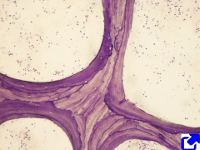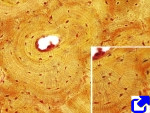Connective Tissues
They show a remarkable extracellular matrix, which is a scaffolding (andamiaje) made up of collagen and elastic fibers, and other molecules.
The type and proportion of these components in the extracellular matrix set the structural, mechanical and biochemical properties of the different connective tissues.
Extracellular matrix features and cell types define the variety of connective tissues.
Functions
- they connect and keep together many organs of the body,
- they provide mechanical support to different parts of the body and to the whole body as well,
- and protect and isolate many organs.
- Furthermore, they allow communication between different parts of the body.
CONNECTIVE PROPER
ADIPOSE TISSUE
BONE
2. Trabecular bone

Trabecular or spongy bone (Figure 2) has large inner spaces known as vascular cavities.
Compact bone

Compact or cortical bone has no vascular cavities, and the extracellular matrix is organized into bone lamellae, which can be arranged straight and parallel (lamellar compact bone) or concentrically around a canal (osteonic compact bone).
Blood is regarded by many authors as a specialized type of connective tissue composed of cells, cell fragments and a liquid extracellular matrix known as blood plasma
BLOOD
Blood has many functions. The following are three salient functions.
1) Communication pathway. Blood transports nutrients and oxygen from intestine and the lungs, respectively, to the rest of the body. Wasting products are transported to the kidney and lungs. It is also the main communication pathway for chemical signals, like hormones, between distant cells in the body.
2) Homeostasis. Blood contributes to the general body homeostasis. For example, it keeps relatively constant the body temperature and pH of tissues.
3) Defense. Blood contributes in the repairing of wounds by sealing the damages with erythrocytes, platelets and plasma, i.e., blood clotting (coagulación). It also contains the cells of the immune system, that use the circulatory system to be transported and attack pathogen in any tissue of the body.
1. Blood cells
Blood cells are classified in two groups: erythrocytes or red cells, and leukocytes or white cells (Figures 1 and 2). There are also cell fragments in the blood referred as platelets.(plaquetas)
Plasma
Plasma is the liquid part of the blood and accounts for more than half of the blood volume. It is 90 % water, and the rest is composed of proteins, ions, amino acids, lipids, and gases. Plasma is the main transporter of nutrients and waste products.

No hay comentarios:
Publicar un comentario